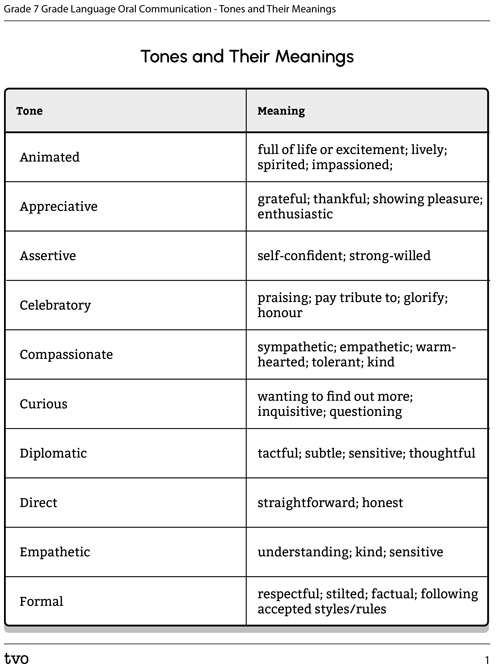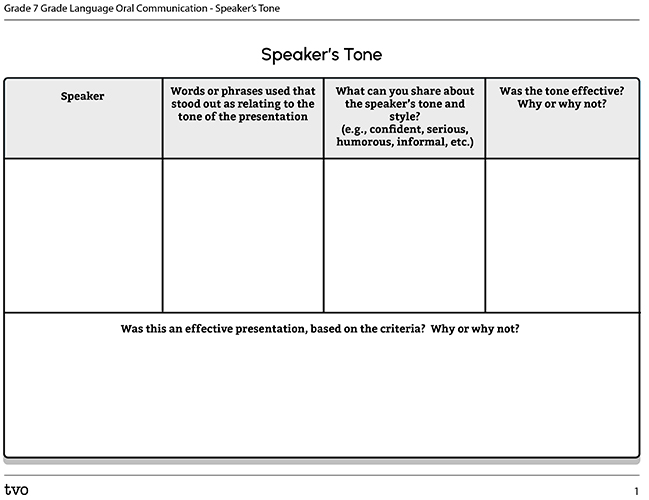Minds On
Purposes of presentations
People create and deliver presentations for many different purposes and to many different audiences.

Create a list of as many different purposes as you can think of why people present. Then, include who the target audience for each of these presentations might be (there might be more than one option for audiences).
Record your thoughts and ideas in the following fillable and printable document Why Do People Present? You can also complete this activity in your notebook or use a method of your choice. There are two examples provided to guide your work.
| Purpose for Presentation | Possible Audience for Presentation |
|---|---|
| to pitch a movie idea | the executive of the movie studio |
| students presenting information learned on a topic in science class | their class and teacher |
Press the ‘Activity’ button to access Why Do People Present?
Action
Task 1: Criteria for effective presentations

There are many different types of presenters and presentations. You may have experienced examples of great presentations. Effective presenters are those who:
- show their confidence, passion, and care about what they are presenting
- communicate a message clearly to their audience
- support their main ideas with evidence, examples, illustrations, and/or facts
- engage their audience with a story about their topic
- use presentation tools wisely, such as charts, videos, audio, and/or animations
Consider these strategies that make an effective presenter.
Option 1: With a partner
Discuss the most important strategies from this list and why you think that strategy is important.
Option 2: Without a partner
Record your ideas orally, digitally, in print or in a method of your choice, what you believe to be the most important of these strategies and why.
Task 2: Effective presentation examples

Explore and analyze these two short excerpts of TED Talks presentations. Reviewing the criteria listed above, which elements did you notice in the presentations that you explored? Use the checklist for each video, or a method of your choice to record your responses.
Criteria for effective presentations
Choose one of the two videos and record the following information about the presentation:
- What was the purpose of the presentation?
- Who was the audience of the presentation?
- Was this an effective presentation, based on the criteria? Why or why not?
Task 3: Tone
Tone refers to a presenter’s use of words and style to convey their attitude towards a topic. If possible, with a partner or independently, explore the following printable document Tones and Their Meanings and examine the list of words that describe tone and their meaning.
The following interactive multiple choice interactive explores the different types of tones and their meanings.
Select the correct answer.
How is tone used?

Explore a video or article of your choice about a topic or person that inspires you (an athlete, an activist, or another person who inspires you) or return to one of the two videos from earlier in the lesson.
What is the tone used, based on the words they used? Was this tone effective for the target audience? You may use words from the list we discussed out loud and observed in written form.
Record your responses in the following fillable and printable document Speaker’s Tone. You can also complete this activity in your notebook or use the method of your choice.
Consolidation
A most interesting presentation

Pretend that you are about to deliver a presentation about one of the most interesting stories, fact, or experiences you could share. As you create your plan for this presentation, consider the following:
- What will the purpose of your presentation be?
- Who will the audience of your presentation be?
- What tone words from the list in the action would be beneficial for your presentation?
- Will you include audio and visual in your presentation? Why or why not?
- What strategies will you focus on in your presentation from the criteria in the action to engage your audience?
Share and record your ideas using a method of your choice.
Reflection
As you read the following descriptions, select the one that best describes your current understanding of the learning in this activity. Press the corresponding button once you have made your choice.
I feel...
Now, expand on your ideas by recording your thoughts using a voice recorder, speech-to-text, or writing tool.
When you review your notes on this learning activity later, reflect on whether you would select a different description based on your further review of the material in this learning activity.

